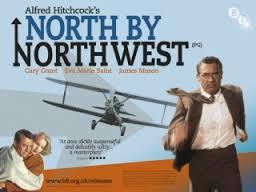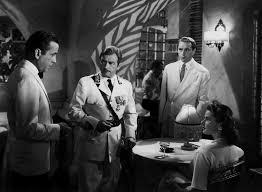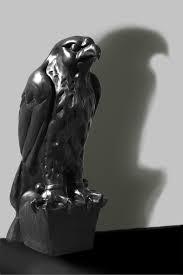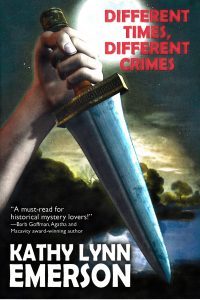Kathy Lynn Emerson's Blog, page 46
April 19, 2017
How Do You Proofread?
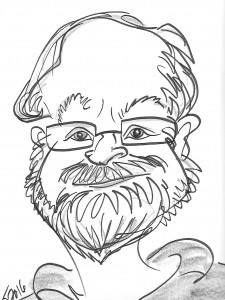
Vaughn
Last month I received the advance reader copy of my novel, WENDIGO, slated for release on July 17 (or earlier depending on what Amazon does–more on that in a future blog) as well as the .pdf file for me to proofread. I had already done the editor revision and a ton of rewrites (I actually started the novel in 1989) and therefore thought I had a pretty tight manuscript. However, I decided to proofread the .pdf file anyhow. Am I ever glad that I did. What I thought was a fine-tuned manuscript turned out to be anything but. This led me to dig into my files for some notes that I made several years ago. I was working on SNIPER, my first novel to be published and had started to proofread it. I thought that I had submitted a highly polished manuscript and was surprised when the editor sent back her recommended revisions. The editor and I discussed what had happened and why I overlooked so many errors when I had proofed it myself. The feedback I received was eye-opening. What I thought was proofreading was in fact, revising.
Revising includes checking each paragraph to make sure your introductory paragraph is engaging and well-written, your concluding paragraph reinforces the purpose of your story or topic, and each body paragraph presents clear information about each aspect of your topic or story. Revise wordiness, cliches, and tautologies. On the other hand, proofreading your text is done after you’ve revised it.
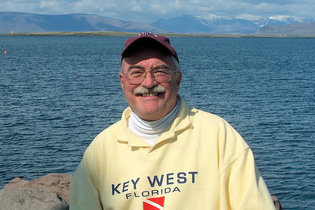
Jeremiah Healy. May 1948 – August 2014
Once you’ve completed your revision process take a break, sleep on it, and return to your text with fresh eyes. Jeremiah Healy once told me that after he finished a novel, he printed hard copy, and set it aside for six weeks before proofing. He believed it took at least that long for your brain to forget what you meant to write. If you begin the process too earlier, your brain will read what it knows you meant rather than what your eyes tell it you actually wrote. Here is the process that she recommended and that I, for the most part, use.
The Proofreading Process
The best way to proofread your text is to print it out. If you decide to proofread on a computer (a process I am unable to do), copy and paste each sentence separately on a fresh word document.
Check your text for grammar and spelling mistakes.
To prevent yourself from thinking about your story or topic while proofreading, read your text out loud slowly. This process will help you to focus on the words and punctuation.
Do not read paragraphs in chronological order. Start with the fourth paragraph, for example, then move to the sixth, the second, the first, the fifth, and the third.
Use a ruler or blank piece of paper to guide your reading. Working in this manner will help you to concentrate on the sentence structure and words. Place the ruler or blank piece of paper below each sentence as you read. Identify and correct punctuation and sentence structure mistakes.
Track your writing errors by making a list of them in your notebook. If you find a sentence with mistakes in it or a misspelled word, write it down in full in your notebook. Write the correct version next to it. Note your writing mistakes. As you compile them you will identify patterns. Note the patterns. They will give you clues to the types of mistakes you repeat when writing.
Proofreading your text will help you to address typos, mixed constructions, run-on sentences, comma splices, sentence fragments, verb errors, pronoun errors, faulty parallelism, and problems with modifiers. After you complete your proofreading process format your document to meet publishing requirements.
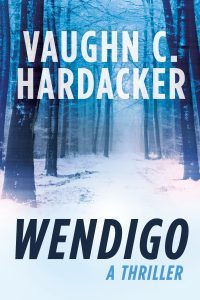
Wendigo: Coming July 2017
April 18, 2017
Murder, Marriage & Mysteries
Today, we welcome Maine writer Joe Souza as our guest to the blog:
Joe Souza: The recent popularity of domestic thrillers in crime fiction begs the question:  what exactly is a domestic thriller? More often than not it involves a crime that in some way touches upon a fragile relationship, usually a troubled marriage. The setting is typically the home or possibly the office, and the main character feels somehow trapped in a situation where there seems to be no escape. Oh yes, and a crime is always involved.
what exactly is a domestic thriller? More often than not it involves a crime that in some way touches upon a fragile relationship, usually a troubled marriage. The setting is typically the home or possibly the office, and the main character feels somehow trapped in a situation where there seems to be no escape. Oh yes, and a crime is always involved.
Once I discovered the joys of reading a good domestic thriller I was hooked on the genre. When reading one I feel like I’m a fly on the wall watching from behind the scenes, understanding the true dynamics of a couple’s relationship. In fact I liked reading domestic thrillers so much that I decided to write one. This after five horror novels, a book of short stories, a kidnapping mystery and a hardbitten crime novel set in Portland.
My first exposure to a real life domestic thriller happened almost twenty-eight years ago. On October 23rd, 1989, an unusual crime happened in Boston. Reports came in that a black man had forced his way into a couple’s car, robbed them, and then shot the two of them before fleeing on foot. This brutal, senseless crime caused racial tensions to escalate in the city, especially since Charles Stuart’s wife and unborn child ended up dying in the attack. As he lay in the hospital with a gunshot wound to his abdomen, Charles recounted to the police his version of events.
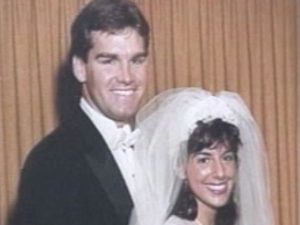 But as police began to dig deeper, Stuart’s lies began to unravel. His brother, Matthew, went to the police and admitted his role in helping Charles pull of this despicable crime. Matthew admitted that the two of them conspired to use the race card in order to hide the true motive for killing Carol Stuart: money!
But as police began to dig deeper, Stuart’s lies began to unravel. His brother, Matthew, went to the police and admitted his role in helping Charles pull of this despicable crime. Matthew admitted that the two of them conspired to use the race card in order to hide the true motive for killing Carol Stuart: money!
I remember obsessively following the case in the news, each day learning new information about the murder. It was as if I was reading a riveting mystery or watching a great suspense movie. I wasn’t the only one mesmerized. The entire region seemed eager to find out who had attacked this seemingly happy couple as they returned home from child birthing classes. They made a handsome pair, too. Charles was tall and good looking, and a successful manager of a fur shop on Newbury Street. Carol was a tax attorney who had graduated from BC and was expecting her first child. This couple seemed to have everything going for them. I remember thinking: why do bad things happen to good people.
Back to Charles’ brother. After Matthew admitted his role in the commission of the crime, confirming the police’s suspicions, Charles’s story began to unravel. Of course, like in any good mystery, it was discovered that he had a whole other side to his personality. He’d tried to convince his wife to abort the child so she could keep earning her high salary. But she refused to give up the child. Because of her pregnancy, she’d gotten the upper hand in their marriage, which shifted the balance of power in her favor. Charles was planning to open his own restaurant after he killed her, using the life insurance money as a downpayment. Oh, and like most cases of domestic intrigue, he had a girlfriend on the side.
Unfortunately, Charles Stuart never got the justice he deserved. As soon as he found out his brother had confessed to the police, he drove to the Tobin Bridge, parked his car alongside the rail, and jumped to his death.
The Stuart case has always fascinated me as both a husband, father and a crime writer. I’d recently graduated from Northeastern when the crime happened, majoring in Criminology and Political Science. The idea that a successful husband would even think to kill his beautiful wife and unborn child seemed completely senseless to me. I wanted to understand the warped psychology of an individual who could commit such a heinous crime. I was intrigued by both the crime itself and the use of racial profiling to deceive the police. The crime itself was deeply flawed in execution, and far from complete, and yet it was brilliantly devious in the most psychopathic way. By playing on white Bostonians racial fears, Stuart sought to create the perfect murder.
The Stuart case was my first real introduction to marital bliss gone wrong, and I often still think about it. What is it about marriage that causes spouses to want to kill each, even in jest? Do you ever wonder how certain couples act in the privacy of their home, away from family and friends? Often, but not always, marital disagreements are about money. Or a secret affair. Almost everyone in a relationship experiences these problems at some time in their life. But only a few twisted individuals resort to criminal behavior to resolve the issue in their favor.
Charles Stuart happened to be one of them.
GONE GIRL by Gillian Flynn was the first domestic thriller that truly captured my  imagination. Flynn is a brilliant writer with amazing insights on marriage and the roles husbands and wives play in their relationships. Her character, Amy, is a wonderful literary creation and one of the most cunning and despicable villains in the genre. I couldn’t read the book fast enough. And I loved her alternating husband/wife first person POVs. GONE GIRL went on to reinvent the domestic thriller and bring it to the forefront as a new kind of mystery. The clever twists and turns astounded me, and made me realize how ripe this genre was to be explored.
imagination. Flynn is a brilliant writer with amazing insights on marriage and the roles husbands and wives play in their relationships. Her character, Amy, is a wonderful literary creation and one of the most cunning and despicable villains in the genre. I couldn’t read the book fast enough. And I loved her alternating husband/wife first person POVs. GONE GIRL went on to reinvent the domestic thriller and bring it to the forefront as a new kind of mystery. The clever twists and turns astounded me, and made me realize how ripe this genre was to be explored.
Since GONE GIRL, I’ve gone on to read dozens of books in the domestic thriller genre. Many of them good, others not so. None of them, in my opinion, matched Flynn’s cleverness, razor sharp insight and plot machinations. But they’ve all piqued my interest in one way or another, and got me thinking about the institution of marriage and the complex dynamics that define it.
So I sat down one day to write my own domestic thriller. Oh, I had wild ideas and intriguing plot points kicking around in my head. The words came our fast and furious. Many plot points changed in the editing process. The result? My agent loved it. He told me it was the kind of book he’d been looking for for quite some time. And the best part is that he sold it in a two book deal to an editor who was equally enthusiastic about the manuscript—and the genre.
Not only are domestic thrillers growing in popularity, but many agents on Twitter (#MSWL-more about this in another blog posts for those seeking agents) are actively seeking manuscripts in this genre. It seems that the reading public has an insatiable need for such fiction, and will for the foreseeable future. It’s why I took a career risk and wrote a domestic thriller, and in the process reinvented myself yet again as a writer.
 I’ve been happily married for over twenty years and have two kids. The only domestic thrills I encounter these days are mundane at best, such as who will take out the trash, do the laundry or dishes. They say the best advice is write what you know, but I’ll leave that to my imagination.
I’ve been happily married for over twenty years and have two kids. The only domestic thrills I encounter these days are mundane at best, such as who will take out the trash, do the laundry or dishes. They say the best advice is write what you know, but I’ll leave that to my imagination.
Joseph Souza is the author of eight works of fiction, He won the Andre Dubus Award, received Honorable Mention for The Al Blanchard Award, and in 2013 won the Maine Literary Award. He grew up in Boston and worked as a teacher, cabbie, social worker, truck driver, editor, bouncer, barber, wrestling coach, paralegal and intelligence analyst in the DEA (Organized Crime Unit), to name just a few. His next novel, The Neighbor, will be published in hardcover by Kensington (6/18) under the John Scognamiglio Imprint.
Mass Booking in Hartland

Yessuh, it was a time all right.
Holli Baker woke up one morning two years ago with an idea. As president of the Hartland-St. Albans Lions Club, she had been working on coming up with a service project that could impact the area in new and significant ways. Anyone familiar with the Lions Club knows they’re pretty civic minded and have collected unwanted eyeglasses to be repurposed for those who cannot afford a pair, as well as raising funds to offer scholarships to promising local high school graduates. Holli had been trying to come up with something new.
What about a family literacy fair? Holli went online to research who had done such events, how successful they had been and what worked best. After she presented her findings, the local club got behind the idea in a big way and in early April of 2016, they held such an event at the Irving Community Center adjacent to the Hartland Consolidated School. They tried to include exhibits, organizations and activities proven to get kids involved.
They expected 50 to attend. At one point, there were over 300 kids, parents and grandparents. The boxes of books they had collected vanished quickly. Perhaps the most telling observation came from the elementary school principal who said that she saw parents at the fair who had never set foot in the school before. It was a day well planned with amazing results.
Fast forward to March of 2017. Ellie Davids, former Lions Club president and member of the Hartland Public Library book group told club members about last years event and that it would be repeated on April 8th of 2017. Beth and I volunteered to help and when we discussed it with the newly formed Hartland friends of the library group, they expressed interest in supporting the fair.
We started collecting age appropriate books in new or gently read condition. Ellie, Beth and I went to the Bangor Literacy Volunteers office on the campus of Eastern Maine Community College where they graciously let us pick through their stash of donated books. We were floored at the variety and condition, returning with over 200. While the literacy fair is geared toward preschool through fourth grade, we wanted to make certain there were books available for older siblings. Ellie had said that last year they even had paperback fiction for parents and other adults to take home.

The prize books in age appropriate order.
The night before the fair, club members sorted the books. There were two areas, one consisted of a series of tables with the new/like new books. Those were offered as prizes for children who visited all the stations (more about that in a moment). The other books were mostly ex-library copies and were on tables in the hallway with no limit on how many a child or parent could take.
Maine authors Lynn Plourde and Bette Stevens came and each read to children twice in the school library. The Hartland Public Library helped by buying new copies of their books to be signed and given to lucky listeners. In addition, Nick Berry, Hartland librarian, participated by having a table where he featured board games that he owns and demonstrated the connection between literacy and gaming.
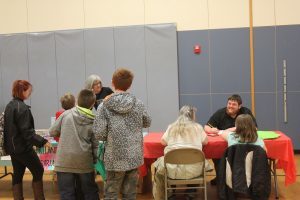
Nick talks gaming
The literacy fair was truly a community event with students from Nokomis High School representing, Junior ROTC, Future Business Leaders of America and Jobs For Maine’s Graduates (JMG) helping by processing registrations, providing face painting, as well as setting up and breaking down when the event was over. They were all poised and extremely competent. Several members of the Hartland Library friends group assisted as well.
Area businesses and other community groups pitched in, including Moose Lake Market (known in town as Rocky’s), Oakhurst Dairy (providing 5 crates of single serve white and chocolate milk cartons), Circle K in Newport, the Sebasticook Valley Credit Union and Literacy Volunteers. If I left any organizations out, I apologize.
This years fair was equally successful, The room was packed, everyone got a free bag lunch and those completing the check list by visiting all the event tables got at least 5 books. There were activities for everyone, including spontaneous theater, reading by flashlight in a tent, handling animal furs, etc. while talking to a Maine game warden, getting information on adult education programs and getting a GED, reading to pets (probably the most popular activity), planting seeds, health screenings and vision exams (more than one parent was flabbergasted to learn their child had a vision problem), dental exams, literacy volunteer information for adults interested in learning to read and many more (see the photo of the poster).
Every child got a new book bag with age appropriate supplies inside. Students from both the Hartland and St. Albans elementary schools had gotten involved ahead of time in a couple ways. They had an art contest with the paintings hung on the wall behind the prize books table and they wrote their own books which were on display at the fair. Several young authors had their works selected for excellence and received prizes.

Some of the young authors’ books
It was an event that generated a ton of smiles and the look of excitement and anticipation as kids went home with new books to enjoy made the day well worth all the time and effort. In addition to the photos I’ve included, you can see more on my Facebook page.
April 16, 2017
Is a MacGuffin Something? Or Nothing?
Susan Vaughan here. In fiction, a MacGuffin, sometimes written McGuffin or maguffin, is a plot device in the form of some goal, desired object, or other motivator that the protagonist and often others pursue. For storytellers as far back as ancient epics, it’s the thing or device that motivates the characters, or propels the plot and action and focuses the audience on a single prop. The specific nature of a MacGuffin can be unimportant to the overall plot. It’s the jewels or the necklace or the Golden Fleece or the elixir or the plans or papers or the microfilm or the secrets that propel the plot.
The term was coined by Alfred Hitchcock, according to Donald Spoto in his book about the director. Michael Kerland, writing for Gotham Writers, says that over the past sixty years, writers, and particularly mystery and thriller writers, have adopted the term as their own. I’m using as examples Golden Oldies because they are likely to be familiar to more people. Let’s start with Hitchcock. The plot of North by Northwest (1959) involves an object that everyone in the film is chasing but which has no deep relationship to the plot.
The movie is a tale of mistaken identity, with an innocent man, Roger Thornhill (Cary Grant) pursued across the United States by spies trying to prevent him from blocking them from smuggling out microfilm containing government secrets. They believe him to be the agent on their trail. It turns out later that there is no such person, that the name was a decoy to keep the spies from suspecting Eve (Eva Marie Saint), the government’s plant.
In an earlier film, Casablanca (1942), the MacGuffin is irrevocable German “letters of transit” that can be used to escape to a neutral country. The plot circles around those letters, and their existence motivates the action. The major distinction between this application of a MacGuffin from the traditional is that, within the first ten minutes of the film, Ex-Pat American Rick (Humphrey Bogart) has the letters in his possession. Much of the plot is about what he will do with them.
Laszlo (Paul Henreid) offers him money. Rick’s former lover and Laszlo’s wife Ilsa (Ingrid Bergman) attempts to repair their love. He refuses them both. In this film, the MacGuffin is not only a plot device, but a character engine as well. Rick must choose between his love for Ilsa and helping her and her Resistance-leader husband escape the Vichy-controlled city. In reality, there was no such thing as letters of transit. People could come and go from Casablanca freely.
In novels, MacGuffins abound. I could spend words on the Ring in J.R.R Tolkien’s Trilogy or the map in Robert Louis Stevenson’s Treasure Island, but since we are Maine Crime Writers, I’m sticking to mystery and suspense and going with the classic example every writer of craft uses—Dashiell Hammett’s The Maltese Falcon (1929). Originally serialized in a magazine, The Maltese Falcon features Sam Spade, the private detective from whom a whole school of hard-nosed American PIs evolved. The MacGuffin is the eponymous statuette of a bird, supposedly having been given in 1539 by the Knights of Malta to the Spanish king and jewel-encrusted beneath the black enamel. To possess the Black Bird, people steal, women try to seduce Spade, and people are murdered. John Huston made his directing debut in the 1931 film adaptation, a film noir classic and another Bogart vehicle.
I used MacGuffins as the plot devices in my Devlin Security Force series. In On Deadly Ground, it’s the Mayan god figurine the characters must return to its temple and that assorted bad guys want for its perceived powers or its monetary value. In Ring of Truth, the MacGuffin is a hidden trove of crown jewels that the hero, whose jewel-thief father stole them, must retrieve in order to clear his name. And in Cleopatra’s Necklace, well, I probably don’t need to explain the MacGuffin in that one.
In a novel or film plot, someone has to be after something, and some force has to be in his or her way, or there’s no story. In order to motivate characters and make the plot one the reader or audience cares about, the MacGuffin has to be plausible and worth the trouble. The MacGuffin isn’t merely the goal the protagonist is striving for; it’s often also the reason for the overwhelming odds.
Some movie buffs argue that a MacGuffin is a meaningless, empty vessel—a gimmick only. If the object being sought could be changed to anything else and the switch doesn’t alter the plot in any way, then you are chasing a MacGuffin. But I disagree. My Mayan god figure is a plot device, the inciting “object” that triggers the search plot, as are the Black Bird in Hammett’s novel or the microfilm in Hitchcock’s movie. Each is the object of the greed or desire or need that moves the plot. I argue that an object is not a MacGuffin ONLY when it does not drive the story.
I’d love to hear from you about other novels or films with MacGuffins.
April 14, 2017
Weekend Update: April 15-16, 2017
 Next week at Maine Crime Writers, there will be posts by Susan Vaughan (Monday) John Clarke (Tuesday), Dorothy Cannell (Wednesday), Vaughn Hardacker (Thursday), and a guest post from Robin MacCready (Friday).
Next week at Maine Crime Writers, there will be posts by Susan Vaughan (Monday) John Clarke (Tuesday), Dorothy Cannell (Wednesday), Vaughn Hardacker (Thursday), and a guest post from Robin MacCready (Friday).
In the news department, here’s what’s happening with some of us who blog regularly at Maine Crime Writers:
Barb Ross: On Monday, April 17, at 7:00 pm, I’ll be appearing at Porter Square Books in Cambridge, MA at “Cozy in the Cafe,” with fellow authors Kate Flora, Clea Simon, Marian Stanley, Sheila Connolly, Carolyn Wilkins, Edith Maxwell, and Kameel Nasr.
On Wednesday, April 19, at 6:00 pm, I’ll be at the Nashua, NH, Barnes and Noble with my fellow Wicked Cozy Authors, Jessie Crockett, Sherry Harris, J.A. Hennrikus, Edith Maxwell, and Liz Mugavero.
Kathy Lynn Emerson: For those who like short stories, a new collection of thirteen I’ve written, some previously published and some not, is now available from Wildside Press and on Amazon. Different Times, Different Crimes is in trade paperback format and sells for $14.99. Stories range in setting from medieval England to present-day Maine.
Lea Wait: Thursday, April 20, at 6:30 p.m. I’ll be celebrating Sisters In Crime’s 30th anniversary at the McArthur Public Library, 270 Main Street in Biddeford, Maine, along with Kate Flora and Maureen Milliken.
Invitation to readers of this blog: Do you have news relating to Maine, Crime, or Writing? We’d love to hear from you. Just comment below to share.
And a reminder: If your library, school, or organization is looking for a speaker, we are often available to talk about the writing process, research, where we get our ideas, and other mysteries of the business. Contact Kate Flora
Save
April 13, 2017
Page Proofs—the final opportunity to change stuff
 Several of us at Maine Crime Writers have been dealing with page proofs this month. What are page proofs, you ask? They are the pages of the book after they’ve been typeset. All revisions and copy edits have been incorporated, the latter after the author has had a chance to see them and reject those that are objectionable (although the final decision on this is up to the editor). This is the version that becomes what used to be called “bound galleys” and goes out to reviewers as an Advance Reading Copy or ARC.
Several of us at Maine Crime Writers have been dealing with page proofs this month. What are page proofs, you ask? They are the pages of the book after they’ve been typeset. All revisions and copy edits have been incorporated, the latter after the author has had a chance to see them and reject those that are objectionable (although the final decision on this is up to the editor). This is the version that becomes what used to be called “bound galleys” and goes out to reviewers as an Advance Reading Copy or ARC.
The page proofs I just sent back to Kensington are for what will be my fifty-seventh traditionally published book, X Marks the Scot, the eleventh Liss MacCrimmon Mystery. To check for typos and other errors, I did a very careful reading over the course of three days, catching a variety of small mistakes and several embarrassing continuity errors, and finding a number of places where I had to ask myself if I was sure I’d checked a detail when I was writing. If I wasn’t sure, this was my last chance to do so.
 At this point, as the cover letter from the Production Editor clearly states, the author is “to make only those changes that are absolutely necessary” and warns that “text cannot be rewritten at this stage.” Ask for too much, and the publisher has the right to ignore you. This can be challenging, especially if you are picky about repetitious words. I don’t mean accidental repetitions, as on page 71 of this book, where the text read “nuked some water in in the microwave.” An example, one I did not ask to have corrected comes on page 105, where “another customer had come in.” in the second paragraph, and in the fifth paragraph, Liss “saw who had come in.” I did ask for a change on page 124, from “It’s certainly possible, but all we know for certain” to “It’s certainly possible, but all we know for sure”—picky? Yes, but if it bothers me, I’ll give you odds that it will bother some of my readers too.
At this point, as the cover letter from the Production Editor clearly states, the author is “to make only those changes that are absolutely necessary” and warns that “text cannot be rewritten at this stage.” Ask for too much, and the publisher has the right to ignore you. This can be challenging, especially if you are picky about repetitious words. I don’t mean accidental repetitions, as on page 71 of this book, where the text read “nuked some water in in the microwave.” An example, one I did not ask to have corrected comes on page 105, where “another customer had come in.” in the second paragraph, and in the fifth paragraph, Liss “saw who had come in.” I did ask for a change on page 124, from “It’s certainly possible, but all we know for certain” to “It’s certainly possible, but all we know for sure”—picky? Yes, but if it bothers me, I’ll give you odds that it will bother some of my readers too.
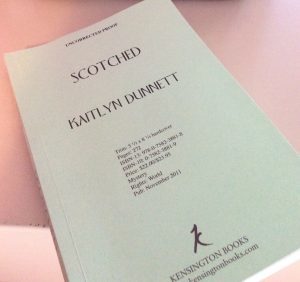
ARC of an earlier book in the series
Continuity is a bigger issue. Most errors were small, but they could have been mistaken for clues. A character likes coffee black in one scene and loaded up with cream and sugar in another. I called a motel the Sleepy Time in one scene and the Day Lily Inn in another. I had a character with a rental car in one scene and driving back home to Connecticut, clearly in his own vehicle, in another. Small stuff, you say, but readers notice. The really embarrassing error, though, was having a character enter a scene and announce that she had good news and bad news . . . and then only deliver good news.
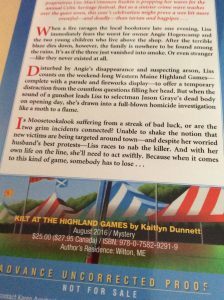
the back copy of another earlier book in the series
No doubt I still missed something. The author is the absolute worst person to proofread his or her own work. We know what we meant to write. Nine times out of ten, that’s what we see, even if it’s not what ended up on the page. Then, too, having read the darned thing so many times, it’s hard to work up a lot of interest in making one more pass. Why did it take me three days to read fewer than 300 pages? Because I knew what was going to happen next and my mind kept drifting off onto other things. I won’t come right out and admit that reading my own writing at this stage sometimes puts me to sleep, but a few times it was a close call and I had to take a break and come back to the page proofs at a later time.
The task complete, nineteen pages with corrections have now gone back to the Production Editor. What comes next? In a month or two I should receive a box of ARCs to use for things like Goodreads giveaways. In December, the hardcover, hopefully with all the corrections made, will be in stores. And a short time after that, inevitably, I will get an email from someone who has spotted an error that I missed.
Kathy Lynn Emerson/Kaitlyn Dunnett is the author of over fifty books written under several names. She won the Agatha Award for best mystery nonfiction of 2008 for How to Write Killer Historical Mysteries and was an Agatha Award finalist in 2015 in the best mystery short story category for “The Blessing Witch.” Currently she writes the contemporary Liss MacCrimmon Mysteries (Kilt at the Highland Games) as Kaitlyn and the historical Mistress Jaffrey Mysteries (Murder in a Cornish Alehouse) as Kathy. The latter series is a spin-off from her earlier “Face Down” series and is set in Elizabethan England. New in May 2017 is a collection of Kathy’s short stories, Different Times, Different Crimes. Her websites are www.KaitlynDunnett.com and www.KathyLynnEmerson.com
There’s still time to catch the Crime Wave!
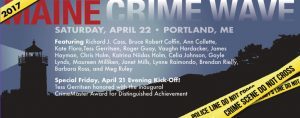 I know what you’re thinking: it’s too late, it’s hard to make plans for a spring Saturday. Geez, I don’t even write!
I know what you’re thinking: it’s too late, it’s hard to make plans for a spring Saturday. Geez, I don’t even write!
Put those thoughts aside, Negative Nelly and Ned. You DO want to go to the Maine Crime Wave. You don’t have to be a writer. Readers, fans and the idly curious are more than welcome.
Here are some of the great panels and happenings:
Debut authors reveal how they got published
Attorneys and law enforcement officers unveil inside info about crime & punishment
Top authors describe how they develop ideas into selling manuscripts
Break-out craft sessions give you the inside scoop on Plot, Character, & Scenes
And let’s say you ARE a writer?
A special hands-on manuscript workshop for four attendees
And join us at 4:00 p.m. for Two Minutes in the Slammer, an opportunity to read your own prose
Experts describe how to write a winning query letter
On top of it, Maine Attorney General Janet Mills gives us the insider’s point of view about crime in Maine.
We eat lunch! It’s included!
And the night before, Tess Gerritsen is honored with the first-ever Maine Crime Master award.
Tess — who’s a great speaker — also talks about the life of a book in the first morning discussion. Writers (like me, Dick Cass, Bruce Coffin and Brendan Rielly) discuss how we got our books published and what it’s like to be newly minted published writers. Some other writers talk about where they get their ideas…
You get the picture.
There are also coffee and pastries and free parking at the University of Southern Maine Glickman Library, right off Interstate 295.
So easy to get to! So fun to be at!
And I promise, the first person who approaches me at the event and says they came because they read one of my posts about it on this blog gets a free autographed copy of my novel COLD HARD NEWS.
So what’s not to like?
There’s still time to register. Just go to mainewriters.org. I promise you, you won’t regret it.
Maureen Milliken is the author of the Bernie O’Dea mystery series. Follow her on Twitter at@mmilliken47 and like her Facebook page at Maureen Milliken mysteries. Sign up for email updates at maureenmilliken.com. She hosts the podcast Crime&Stuff with her sister Rebecca Milliken.
April 11, 2017
Spring’s Sweet Rituals
By Brenda Buchanan
Winter’s cold, dead fingers were pried away from Southern Maine this week.
No one mourned.
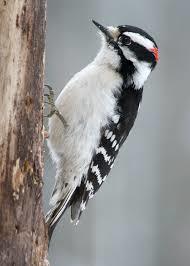
A woodpecker in spring. Not my guy, who is too wily for me to get a shot of him drumming.
This year’s transition to spring demanded the same kind of emotional fortitude one needs to get over a bad head cold that gives way to a nagging cough. But on April 8 nature flipped its switch, and now signs of spring are everywhere.
A male woodpecker drums each morning on a maple tree in our front yard. Finally warm enough to sleep with a window open, there’s no ignoring the boisterous love song as he marks his romantic territory. But after a March that seemed to last 62 days rather than 31, fresh nighttime air is well worth the un-muffled racket of an eager-to-mate woodpecker.
In other bird news, the goldfinches are showing off their spring plumage, red-winged blackbirds were flashing about at the pond behind Scarborough Beach last Sunday, and a snowy egret stood posed as though for a portrait in the marsh along Black Point Road.

The arrival of red-winged blackbirds heralds the change of season.
In a few weeks the warblers will arrive with their fabulous songs. We’ll grab our binoculars and make the trek to a few favorite birding spots to see who’s migrating through, one of the year’s happiest rituals.
We raked the winter mulch off the tulip beds on Sunday and crocus are popping up all over the yard. One evening this week we’ll give the shade garden its annual compost snack then wait for the hostas and ferns to emerge.

Tulips-to-be in our front garden, now that the snow has melted and winter mulch has been raked away.
Soon we’ll plant seed in a raised garden bed fitted with a cold frame and a month later we’ll be eating our own salad greens, spinach and chard.

A tangle of winter attire, finally removed from the back seat of my car.
My heavy parka has been relegated to the back of the closet where its lightweight sister will join it soon. Come hell or late snow, the only boots I’ll wear for the next eight months or so will be hikers. My snow boots are packed away in favor of regular shoes, sneakers and—soon—sandals.
The pile o’ hats, mittens and scarves that lived in the back seat of my car for the past several months have been replaced with a Red Sox cap, just in time for the start of the season.
One night last week I stayed up way too late watching a 0-0 game into the twelfth inning, when a dramatic three-run homer broke the tie and gave us the win.
[image error]
Spring headwear
I struggled through the offseason more than ever this year. Since November the TV has been something to avoid, but the Sox make it safe to pick up the clicker again.
This weekend we’ll wash the windows and put up the screens.
The bikes are winking at me from the back of the garage. Time to pump up the tires.
Soon the flannel sheets will be replaced with cotton and the grill will start to get regular use.
In the meantime we’re listening for the first peepers of the season, welcome music that serves the same happy purpose as the woodpecker’s rat-a-tat-a-tat-a-tat call for companionship.

Every wonder how such tiny frogs make so much noise? Here’s your answer.
BLOG READERS: WHAT ARE YOUR SPRING RITUALS? HOW DO YOU KNOW WHEN WINTER IS DONE?
Brenda Buchanan is a former newspaper reporter with deep respect for small town journalism. The three books in her Joe Gale Mystery Series (Quick Pivot, Cover Story and Truth Beat) feature an old-school reporter with modern media savvy who covers the Maine crime beat. Brenda can be found on the web at www.brendabuchananwrites.com.
April 10, 2017
A Key West Literary Tour
by Barb Ross, who’s back in New England but is offering one last Key West post
On Saint Patrick’s Day, Bill and I went on a Key West literary walking tour, along with author Lucy Burdette and several friends. Key West is rich in literary luminaries, the only city other than New York and LA to have seven Pulitzer prize winners living there simultaneously. The best known Key West authors are Ernest Hemingway, who lived there from 1931 to 1940 and whose house at 907 Whitehead Street is a museum, and Tennesse Williams who who started visiting Key West in 1941 and purchased a home there in 1950, which he owned until his death in 1983. There is a permanent exhibit in his honor.
But the point of this tour was to find some lesser known author homes, first apartments in the city, private homes, and so on. The tour guide, Sarah Thomas, did a great job marching her twelve charges around the streets full of Saint Patrick’s Day revelers.

Sarah Thomas, walking tour guide
Shel Silverstein

Shel Sliverstein,was an artist, songwriter, and author of the children’s classics, A Light in the Attic, Where the Sidewalk Ends, and The Giving Tree, (a particular favorite of my children). He later bought a home on William Street, but his first apartment was on Caroline Street. Jimmy Buffet wrote the song, “Woman Gone Crazy on Caroline St,” about Silverstein’s landlady.
Thomas McGuane

Author Tom McGuane came to Key West in the crazy 1970s. Best known at that point for the novel, Ninety-Two in the Shade, he also directed the movie starring starring Peter Fonda, Warren Oates, Margot Kidder and Harry Dean Stanton. I’ll let the Tampa Bay Times explain what happened next, since I can’t keep it straight.
He divorced his wife, Becky, and she ran off with both lead actors in Ninety-Two, Warren Oates and Peter Fonda. (She was married to Fonda for 35 years.) McGuane had a wild and public affair with actor Elizabeth Ashley, who made their romance even more public when she documented nearly every act of coitus in a memoir. While that affair continued, he fell in love with the film’s young starlet, Margot Kidder, whom he eventually married. That marriage ended quickly, and McGuane fell in love with his best friend’s, [Jimmy Buffett’s] sister. Decades of sobriety and artistic maturity followed. [He and Laurie Buffett McGuane are still married.]
Judy Blume

Author Judy Blume is a current resident of Key West. She and her husband were instrumental in creating the Books and Books store in the Studios of Key West and they often volunteer there. Our tour guide said that recently when she was in the store a customer approached Judy Blume for a recommendation of a book for a thirteen year-old girl, having no idea…
Ernest Hemingway
[image error]
Before they bought their house in Key West, Ernest Hemingway and his wife Pauline stayed in this apartment over the Ford Dealership while they waited for their new car to be delivered to Key West. Hemingway finished A Farewell to Arms there in 1928.
Robert Frost

Robert Frost spent part of sixteen winters in this cottage on the grounds of the home of Jessie Porter, a native Key Wester, hostess and preservationist who often entertained literary figures including Wallace Stevens, Archibald MacLeish, and Thornton Wilder. Frost wrote his famous poem, “The Gift Outright,” which he read that the inauguration of President John F. Kennedy in the cottage. If you need the inspiration, you can rent it from AirBnB.
I’ve given you only a taste of the tour, which, of necessity, can barely touch the surface of Key West authors. I’ve left out Elizabeth Bishop, Richard Wilbur, John Ciardi, John Hersey, and Ralph Ellison, among so many others.
But by that time on Saint Patrick’s Day evening, the crowd was looking like this:

And it was time to move on.
[All photos in this post are by Bill Carito. If you like them and want to see more, you can friend him on Facebook at https://www.facebook.com/bcarito and follow him on Instagram at @billcarito and @bill.carito.colorphotos.]
Save
Save
Save
Save
Save
Save
Save
April 9, 2017
The Nixed Nest of the Girl on the Train
Inspiration (from the Latin inspirare, meaning “to breathe into”) refers to an unconscious burst of creativity in a literary, musical, or other artistic endeavour.
Kate Flora: From time to time, we authors find ourselves scanning bookstore shelves, reading best-seller lists and reviews, and trying to put our fingers on what moves a book from ignored or midlist to best seller status. Is it the catchy two word title, like The Nix or The Nest or The Help? Is it, as recently seemed to be the case, anything with the word “Girl” in the title? Will it help to read James W. Hall’s book, Cracking the Code of the Twentieth Century’s Biggest Bestsellers? All of this reminds me of the playing the game of trying to find the perfect blog title that will evoke Maine and mystery: The Lobster with a Candlestick in a Downeast Lighthouse.
 Usually, except for those books that are discovered by booksellers who love them and hand-sell them to their patrons, most of what makes a book take off is the marketing behind the book. That is publishers putting their money behind the book and getting it recognition through ads and reviews that bring it to reader’s attention and paying for prominent placement in bookstore displays. These days, the clever and informed use of twitter and Facebook ads can also help to promote a book.
Usually, except for those books that are discovered by booksellers who love them and hand-sell them to their patrons, most of what makes a book take off is the marketing behind the book. That is publishers putting their money behind the book and getting it recognition through ads and reviews that bring it to reader’s attention and paying for prominent placement in bookstore displays. These days, the clever and informed use of twitter and Facebook ads can also help to promote a book.
If you don’t have a publisher behind you spending those big bucks to promote the work, the job is harder. How do writers strike the balance between the time spent writing and the time spent getting readers to buy our books? What are the best avenues for promotion and do they do any good? How do we avoid hitting Facebook several times a day to scream: BUY MY BOOK! and tweeting: “There’s a killer out there targeting police officers. How will one determined detective keep it from happening again?” so that everyone will rush out and buy Led Astray?
I don’t know the best ways to market a book. And I confess, now that we’re three paragraphs into this post, that I don’t really want to write about marketing and promotion today. I’m more concerned about how the demands of marketing and promotion clash with the more quiet, yet more passionate, pursuit of craft and story. And with a question that has been very much on my mind lately as I’m entering my thirty-fourth year of sitting at this desk telling stories: does it make sense to keep writing–and publishing–if you are sick to death of the “buy my book” dance? Is it reasonable to keep writing if you aren’t keen on marketing? Or perhaps more particularly, can a writer prioritize the passion and the magic of writing and turn her back–for a time, at least–on the demands of marketing?
Yeah. I’m kind of suffering from a case of “I don’t wanna.” There is hope for this malady,  though. Over the years, something I have learned is that the best way to shake off angst or a bad case of the “I don’t wanna’s” is to take chances. Explore a new corner of the genre. Write something that feels like it is out of my comfort zone. Try writing short stories for a while instead of working on novels. Or go out and explore someone else’s world, as I did with Finding Amy, Death Dealer, and A Good Man with a Dog. My muses tend to come in unexpected forms.
though. Over the years, something I have learned is that the best way to shake off angst or a bad case of the “I don’t wanna’s” is to take chances. Explore a new corner of the genre. Write something that feels like it is out of my comfort zone. Try writing short stories for a while instead of working on novels. Or go out and explore someone else’s world, as I did with Finding Amy, Death Dealer, and A Good Man with a Dog. My muses tend to come in unexpected forms.
Right now, I’m waiting for the inspiration to take a chance to ring of my doorbell or call me up. If this sounds passive, it doesn’t feel like that to me. Every time my writing has gone in a new direction, it has been because somehow while I thought I was going straight ahead, doing the same old thing, fate gives me a nudge. Joe Loughlin needed help writing a book. The Maine wardens sent me to Miramichi, New Brunswick, to explore a story. Susan Oleksiw decided it would be interesting to explore New England crime writing through the medium of the short story and Level Best Books was born. I started writing Joe Burgess police procedurals because my Thea Kozak series was dropped by the publisher.
Right now, even though I am very intrigued by the plot of my new Thea Kozak mystery, my writing feels kind of like a holding pattern. But one day soon, the phone will ring, or an e-mail will come, or I’ll have a random conversation or drive by something that spurs my imagination, and the new direction will be revealed.
So, dear readers, two questions:
How do you shake off the “I don’t wanna’s?”
What do you all think of me working with a cold case detective?

